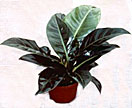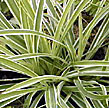Gaylord Moore, horticulture specialist, University of Missouri Extension, offers his recommendation for the 10 toughest house plants for the green-thumb-challenged:

Cast Iron plant (Aspidistra) gets its name from its ability to withstand hardships. It is tolerant of poor light, high temperatures, low humidity and improper watering. It has dark green vertical leaves up to two feet in length. It is often planted outside in hard to fill in areas. It speads easily by underground stems in a dark area of the garden.

Chinese evergreen (Aglaonema) has waxy leaves of either solid green or with variegation. It grows a foot or more tall, but may lose lower leaves and eventually become leggy. The top can be cut off and easily rooted in clean, moist sand. It is tolerant of poor light and overwatering.

Snake plant (Sansevieria or mother-in-law’s tongue) has long stiff, upright spear-like leaves. The dwarf bird’s nest form is also very durable. Snake plant grows best in good light, but endures poor light. It easily can be rooted for transplanting.

Heart-leaf philodendron, along with other philodendrons, is well adapted to home conditions. Although it tolerates moisture fluctuations, it should be kept fairly moist. Position this plant where its vines can be left undisturbed. Since the leaves position themselves for maximum light absorption in poor light conditions, moving these flexible vines cuts down their efficiency and may lead to yellowing.

Devil’s Ivy (scindapsis, Pothos) looks similar to heart-leaf philodendron. Leaves usually contain yellow or cream-colored variegation. It also tolerates fairly poor light and erratic water. In conditions with good light and higher humidity, leaves develop larger and become more colorful. It is very toxic.

Corn plant (Dracaena) is one of several dracaenas that make good houseplants. The leaves project from the main stem in all directions, and are shaped similarly to the leaf of corn. Leaves may also be banded, striped or margined with yellow or cream. In poor conditions lower leaves may gradually drop off, but the bare stem is still attractive, giving taller plants a tree-like effect.

Spider plant (Airplane plant, chlororophytum) is excellent as a hanging plant. It has long drooping leaves with white stripes. Small plants are produced on stems after flowering. This occurs after plants are potbound. Runner plants may be left on the old plant, or removed to start new ones. Leaf tips brown under low humidity or other poor growing conditions.

Ponytail palm (Elephant foot, Beaucarnae) stores water in the base of its swollen stem so it works well for people who forget to water. Although it is fairly tolerant of low light, it is a plant that needs bright light to grow and develop well. It has a tuft of long, thin leaves on top of a central stem that swells greatly near the soil line.

Inch plant (Wandering Jew, Tradescantia) refers to several different vining plants with small leaves that are most used in hanging containers. Although they are durable, vines become stringy and occasionally must be renewed by starting new plants from cuttings that root easily.

Burn plant (Aloe vera) is a plant that has gained popularity because of its apparent ability to ease damage to the skin. It is easy to grow, but needs good light. It is a durable novelty.
For more information, or answers to your specific lawn and garden questions, contact Gaylord Moore, horticulture specialist, University of Missouri Extension at (417) 862-9284, or the Greene County Master Gardener Hotline at (417) 862-9284.






Comments